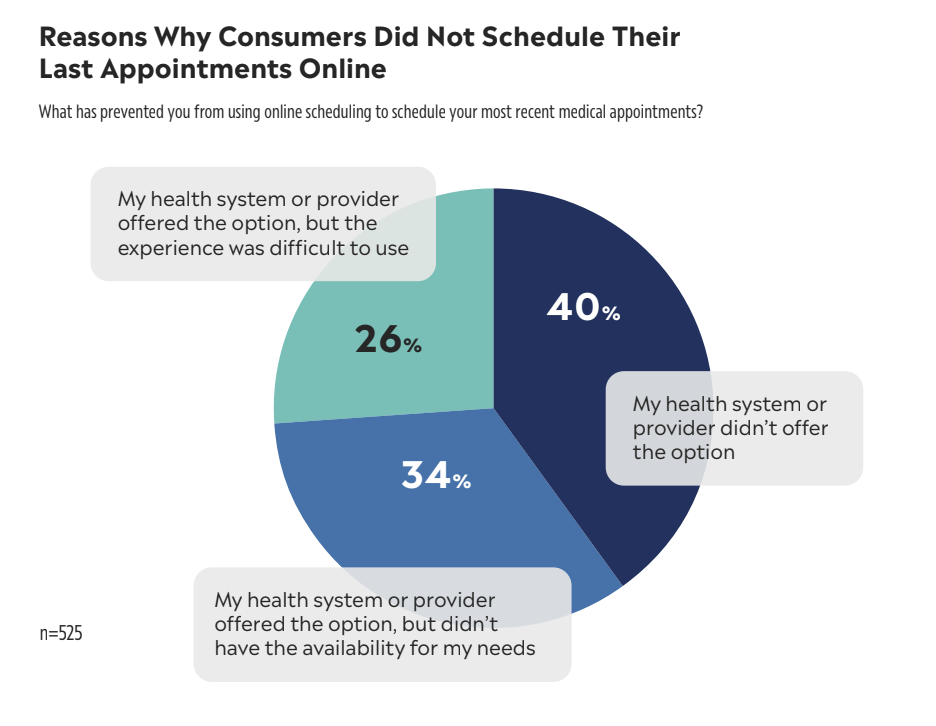The healthcare industry is undergoing a digital transformation. Patients increasingly expect the level of convenience and ease of access they experience in other aspects of their lives. To meet these expectations, hospitals need to provide digital self-service options. EHR-integrated provider search and patient self-scheduling are options that allow patients to find and manage care on their own terms.
This article explores how MEDITECH hospitals can implement digital self-service solutions that improve patient access. The discussion also covers the importance of meeting consumer expectations with digital solutions, the benefits of reducing administrative burden through automation, and the impact of consistent, accurate provider information on the overall patient experience. Finally, the article provides a crawl, walk, run framework that MEDITECH hospitals can use when implementing digital self-service.
Consumer Demand for Enhanced Patient Access
In today’s rapidly evolving healthcare landscape, patients expect the same digital conveniences they experience in other aspects of their lives. Scheduling a car service, booking a flight, or even ordering groceries can be done with a touch of a finger. Patients want to be able to find information about a provider or care option and schedule appointments anytime, from anywhere.
A recent survey shows that over 70% of consumers consult the internet when searching for care. Furthermore, almost 40% prefer patient online scheduling over other channels. This growing demand for digital self-service is reshaping the way healthcare organizations run. Hospitals that fail to adapt will struggle to remain competitive and risk losing their independence.
Kyruus Health, a leading provider of patient access solutions, understands the unique needs of MEDITECH hospitals and has Expanse-integrated digital tools that help attract new patients and easily manage workflows. With just a few clicks, patients can now access the right care without having to call the doctor’s office or wait on hold. More than improving only the patient experience, this also reduces administrative burden. Front office staff members, allowing them to focus on other, higher-value work.
Patient Self-Scheduling Can Generate Operational Efficiencies & Increase Patient Satisfaction for MEDITECH Hospitals
The healthcare industry has been slow to adopt digital self-service in comparison to other industries, but there are signs that this is changing. Consumers increasingly expect to be able to manage their healthcare online. Hospitals and clinics that fail to meet these expectations risk losing patients to competitors that do.
The benefits of digital self-service for healthcare organizations are numerous. These tools can help to improve patient satisfaction, reduce administrative burden, and streamline operations. Reducing administrative burden is one of the most important benefits of digital self-service. By automating tasks such as scheduling appointments, hospitals and clinics can free up their staff to focus on other activities. More attention on higher-value work leads to shorter wait times, better quality of care, and reduced costs.
Digital self-service can also lead to improved patient satisfaction. When patients are able to access their medical records, schedule appointments, and perform other tasks online, they feel more in control of their care. This can lead to increased trust in their providers and greater loyalty to an organization.
Improved Provider Search and Patient-Provider Matching
Easy navigation and accurate information are essential for an effective provider directory solution. Patients should be able to effortlessly search for providers, locations, and services based on specialty, insurance, and availability. An intuitive interface and user-friendly design contribute to a positive patient experience and ensure patients can easily look for and find the right information.
Regularly updated information on provider availability, qualifications, and specialties is crucial. Patients can make well-informed decisions about their healthcare when provided with accurate information, leading to better patient-provider matching. This not only enhances patient satisfaction as they are matched with the best care for their needs, but it also builds trust with providers as they are seeing the right types of patients come through their door.
24/7 MEDITECH Expanse-Integrated Patient Self-Scheduling
Healthcare’s digital transformation demands an elevated patient experience, encompassing ease of access, prompt response times, and convenience. Integrating patient self-scheduling with MEDITECH Expanse is a vital step in achieving this goal. It enables patients to schedule appointments at any hour of the day that is convenient for them.
While patient self-scheduling is not a new concept, there are many organizations who have yet to adopt the capabilities. Furthermore, those that have, do not necessarily have an intuitive user-experience. A whopping 40% of consumers noted in a recent survey that they did not schedule their last appointment online. They could not do so because they didn’t have the option available to them. On the other hand, 26% said it was because the experience offered was difficult to use. It’s not enough to offer patient online scheduling, it must be offered in a way that is simple to navigate.
Patient self-scheduling should not solely be limited to an appointment with a doctor, either. Patients are increasingly looking for the ease of scheduling a variety of different appointment types online such as mammograms, lab tests, urgent care, and other service-based appointments. Providing an option for patients to self-schedule with advanced practice providers (APPs) for lower acuity cases can allow patients to be seen sooner—increasing patient satisfaction and helping MEDITECH organizations with capacity utilization by enabling clinicians to practice at the top of their license.
A Phased Approach to Integrated Search & Patient Self-Scheduling
Hospitals seeking to adopt digital self-service don’t have to do it all at once. Organizations may find it helpful to adopt a “crawl, walk, run” strategy. This approach breaks down digital implementation into manageable phases, ensuring a smooth transition for both the organization and its patients.
The “crawl” phase involves laying the foundation for digital transformation by establishing essential capabilities. These initial steps familiarize patients, providers, and staff with digital tools while laying the groundwork for more complex functionalities.
The “walk” phase focuses on expanding the range of digital services offered. As patients, providers, and staff gain comfort and familiarity with accessing care digitally, hospitals can extend their reach and accommodate more patient preferences, thus resulting in increased patient satisfaction and retention.
Finally, the “run” phase entails continuously enhancing the digital experience to remain competitive and meet the ever-evolving needs of patients.
For more details on the crawl, walk, run, strategy, see the Guide to Digital Self-Service for MEDITECH Hospitals.
Overall, the “crawl, walk, run” strategy provides MEDITECH hospitals with a structured and realistic approach to digital transformation. By prioritizing a user-friendly provider directory solution, integrating patient self-scheduling, and adopting a phased implementation approach, MEDITECH hospitals can enhance patient engagement, streamline operations, and achieve greater competitiveness in the rapidly evolving healthcare landscape. Embracing digital self-service is no longer an option but a necessity for healthcare organizations committed to delivering exceptional patient experience and staying ahead of the curve in the digital age.







